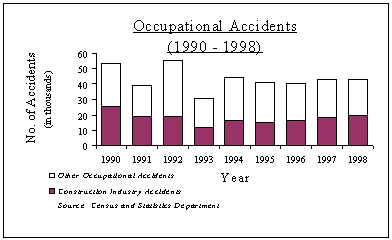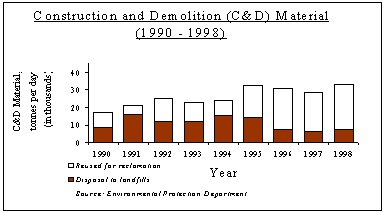Chapter 2 : Problems Perceived
2.1 The HA is the largest housing provider in Hong Kong. To date, it has provided about 645,000 rental and 300,000 home ownership units. Its construction programme is huge, with work underway on 132 sites, comprising about nearly 180,000 new housing units as at end 1999. Capital construction expenditure in 1999/2000 is budgeted at HK$28 billion. In 2000/01 alone, the HA will complete over 90,000 new units. This level of housing production is unprecedented.
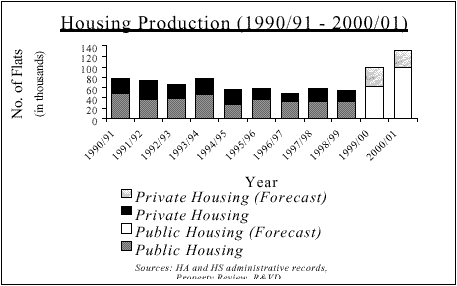
2.2 As the largest housing developer in Hong Kong, the HA has been taking a leading role in promoting building quality. In the 1990s, we have upgraded quality assurance in the industry by requiring International Organization for Standardization (ISO) certification for our contractors and consultants. We have promoted the employment of trade-tested workers and site safety campaigns through contract requirements. We have improved construction productivity and quality through the use of prefabricated components and large-panel formwork. Public housing designs and buildability have also been improved with the introduction of the Harmony and Concord blocks. With the concerted efforts from the Government and the industry, we have assisted in upgrading the buildability of public housing and the professionalism of the industry.
Rising Community Expectation
2.3 Given the community's rising expectation on building quality, the quality agenda will be broadened to "Total Quality" in the 21st Century. Apart from satisfying customers' rising expectation in design and engineering quality, we need to address increasing emphasis on technological and process improvement. We also need to tackle growing community concerns on how construction will impact on our workforce, economic competitiveness and the environment.
2.4 Our recent indepth diagnosis of building quality problems suggests that there are some inherent weaknesses in both the construction industry and the public housing production system, which together compromise building quality. The particular pressure of the recent production peak has exposed these weaknesses. These weaknesses and the problems of building quality which flow from them can be viewed from the perspectives of both stakeholders and the community. The views of both are set out below to provide a context for our proposals for change.
Perspective of Stakeholders
2.5 Building is a complex business, involving inputs and participation from many stakeholders. In the case of public housing, we may appraise the problems from the perspectives of three key stakeholders : the industry, the HA and customers.
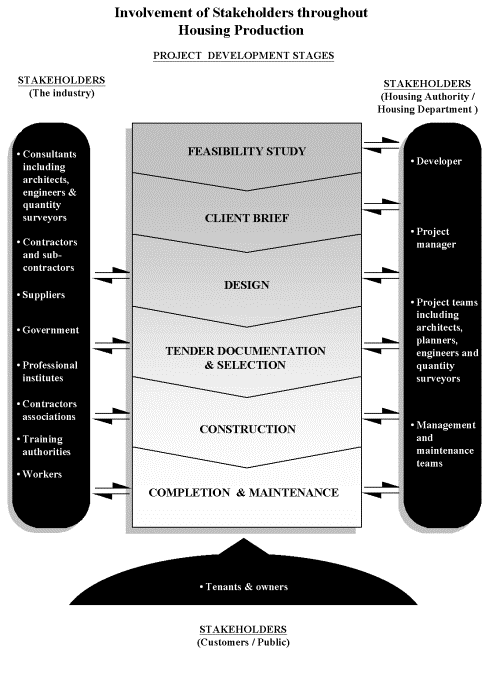
| (a) | From
the industry's perspective, perceived problems include :
heavy workload and tight construction programmes; cut-throat
competition in tendering; high mobility of workers and
sub-contractors; unfair reward and punishment mechanism; lack of
skilled workers and professionalism; periodic general labour
shortages; changing expectations of customers; lack of mutual trust
with developers; cumbersome and inflexible practices of the Housing
Department (HD). |
|
| (b) | From
the HA's perspective, perceived problems include : confusion
in roles and responsibilities amongst stakeholders; heavy and uneven
workload and tight completion schedules; lack of partnering with
contractors and consultants; inadequate supervision by consultants
and contractors; overly rigid systems and practices within the HD. |
|
| (c) | From the customers' perspective, perceived problems include : poor workmanship; lack of adequate avenues for recourse against developers; lack of third-party audit on public housing; over-emphasis on tender prices rather than quality; lack of incentive for public bodies to improve and innovate; poor project supervision; and multi-layered sub-contracting activities. |
Perspective of the Community
2.6 From a macro perspective, the community expects the industry to perform better in three areas -
| (a) | Reducing
construction costs
Hong Kong's building costs are amongst the highest in developed countries. Comparison of
private residential construction costs |
| Multi-storey Buildings |
Hong Kong | United Kingdom | Australia | Singapore | United States |
| High quality | 1,300 - 1,750 | 1,225 | 900 - 1,100 | 1,000 | 850 - 950 |
| Medium quality | 1,200 - 1,300 | 1,000 | 850 - 900 | 800 | 700 - 800 |
| Ordinary quality | 1,000 - 1,200 | 850 - 1,050 | 800 - 850 | 700 | - |
| (Source : | Levett & Bailey Chartered Quantity Surveyors and Frankin & Andrews (Hong Kong) Ltd. All costs are in US$ per Construction Floor Area (CFA) m2) |
| (Note : | Costs may vary as exchange rates fluctuate. Variations in building designs and regulations in different regions will affect comparisons) |
Indeed, the construction cost of the HA's rental Harmony blocks increased by nearly 55% between 1994 and 1999.
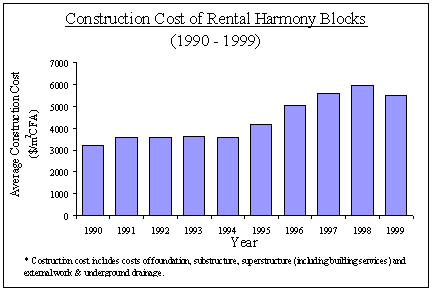
| (b) | Reducing
accidents
Construction sites have traditionally been regarded as dangerous places. Despite the safety campaigns launched in recent years, the industry's safety record is poor. In 1998, the number of accidents in construction industry accounted for nearly 45% of all occupational accidents in Hong Kong and fatal accidents constituted 80% of the overall total. Inadequate site safety management, lack of safety awareness amongst workers and supervisors, and time-based bonus systems may contribute to this.
|
| (c) | Reducing
waste
Between 1994 and 1998, the total volume of construction and demolition material Note 2 increased by 40%. In 1998, about 7,000 tonnes of construction and demolition waste were brought to landfills each day, while about 27,000 tonnes of public fill were reused for reclamation daily.
|
2.7 Some of these problems have existed for a long time and recent incidents serve as an over-due wake-up call. They can help the industry to focus on these problems and re-think the operations. It is time for all stakeholders to tackle these problems decisively and together to enhance building quality and safety in the new millennium.
| Note 2 | Construction and demolition (C&D) material is a mixture of inert and organic material arising from site clearance, excavation, construction, refurbishment, renovation, demolition and road works. The inert material, known as public fill such as excavated soil and rock, concrete and debris from demolition, is suitable for reuse in reclamation and site formation works. Some of it can also be used for recycling into material for construction. The organic non-inert material called C&D waste such as timber, paper, glass, junk, general garbage should be disposed of at landfills. |
